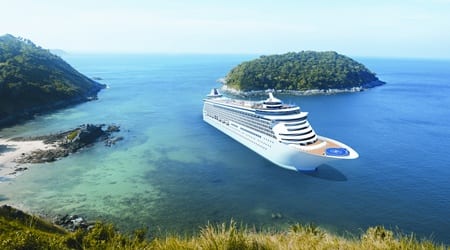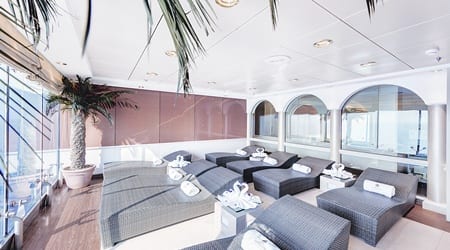The Wave Forward
Strategically positioned in South Asia and with a coastline of more than 7,500 km, India’s potential to emerge as a global cruise destination is indubitable. However, easing port taxes and improving port infrastructure, developing river cruising and cruise circuits, among others is the need of the hour By Rituparna Chatterjee

Initially considered to be the privilege of the elite, the only option for the aged and an obvious choice for the honeymooners, the cruise tourism market has over the years broken away from this stereotypical image to appeal to a much larger traveller base. Today, cruise tourism is becoming an increasingly popular leisure choice worldwide thereby gaining greater significance in the global tourism pie and creating a niche for itself. Recognising cruise tourism as a thrust area, the government of India has been wanting to promote the cruise tourism industry and position India as a global cruise destination. The possibilities for achieving this goal are immense. For instance, firstly, India with its more than 7,500 km of coastline dotted with places of interest along with 12 major ports and 184 minor ports imparts a natural advantage to the country to attract international cruise liners. Secondly, India’s reputation as an exotic, historic and beautiful destination can be used to position the country as an international cruise destination and move into this market. Thirdly, India’s positioning in South Asia and its proximity to popular cruise destinations also opens up the prospect of creating strong cruise circuits over a period of time. And lastly, India’s robust domestic tourism sector can also be tapped to develop a strong domestic cruise sector that can complement the growth and support viability. “India has always been a preferred tourist destination for passengers worldwide. With the introduction of e-visa to 113 nationalities worldwide, inbound traffic to India has been on the rise consistently. By possessing a coastline of around 7500 km covering beautiful tourist destinations, India can definitely become a popular cruise destination in the future,” opines Kunal Sampat, general manager – India, MSC Cruises.

Despite these advantages, factors that have been prohibiting the positioning of India as a cruise tourism destination are the lack of basic cruise-related infrastructure at ports, a complex tax regime coupled with tedious immigration processes, among others. Adding to this is the laws of the land which prohibits passengers on board cruise ships doing stopover at Indian ports from cruising between the country’s ports. “These laws need to change to make the cruise experience conducive for Indian passengers, similar to other nationalities. The infrastructure currently does not help tap this potential either and there are challenges on multiple fronts whether in the form of local transportation options, safeguards against overcharging or even the immigration process itself,” states Ratna Chadha, chief executive, Tirun Travel Marketing, the exclusive India representatives of Royal Caribbean International, Celebrity Cruises and Azamara Club Cruises. Though many international cruise companies are lobbying with the Indian government to address these challenges, any action in this respect are yet to be seen.
Rising potential
 Interestingly, although India lacks the basic cruise-related infrastructure, Indian ports have been able to attract a substantial number of cruise vessels and tourists in recent years. For example, MSC Orchestra was the first ship of MSC Cruises to sail through Indian waters in February this year, en-route its grand voyage starting from Dubai to Australia. “The overwhelming response received from the India market for Dubai to India as well as for India to Singapore sailings has given us the confidence that India can be a great cruise destination and we are definitely looking forward to having more such sailings in the future,” believes Sampat. As for Royal Caribbean International, its cruises have been doing call at Indian ports en route to/ from Europe to Asia and vice versa.
Interestingly, although India lacks the basic cruise-related infrastructure, Indian ports have been able to attract a substantial number of cruise vessels and tourists in recent years. For example, MSC Orchestra was the first ship of MSC Cruises to sail through Indian waters in February this year, en-route its grand voyage starting from Dubai to Australia. “The overwhelming response received from the India market for Dubai to India as well as for India to Singapore sailings has given us the confidence that India can be a great cruise destination and we are definitely looking forward to having more such sailings in the future,” believes Sampat. As for Royal Caribbean International, its cruises have been doing call at Indian ports en route to/ from Europe to Asia and vice versa.
In the Tourism 2020 Vision document, WTO forecasts that India has the potential to reach nearly 8.9 million international arrivals by 2020. A WTO study indicates that averages of 1.4 per cent of all international arrivals across the world are cruise tourists. Considering that, once cruise facilities are developed in India, the same per cent would be applicable, thereby arriving at a potential market for cruise tourism. However, India should not restrict itself into tapping only foreign tourists comprising international arrivals in India but also focus on attracting other distinct tourism segments such as Indian tourists comprising outbound travellers, Indian tourists who are domestic travellers and cruise tourist arrivals in India.
Cruise circuit
According to a 2015 report titled ‘Market Potential for Cruise Tourism In India’ brought out by International Research Journal of Business and Management, India ranks as the ninth most popular tourist destination in the world and is today considered as a preferred cruise destination. The government of India, as part of its cruise tourism development initiatives, has identified six Indian ports to be developed as ‘world class cruise terminals’ and to be promoted as ‘integrated Indian cruise circuit.’ These ports include Mumbai, Goa, Cochin, New Mangalore, Tuticorin, and Chennai. It is to be noted that these cruise ports selected for development are also strong tourism states, especially Kerala, Goa and Chennai thereby providing a ready platform for cruise tourism to takeoff.
Singapore’s Success Story
Q&A with Chang Chee Pey, executive director (South Asia, Middle East and Africa), Singapore Tourism Board
What favourable factors has helped Singapore to develop itself into a cruise tourism hub?

Key factors that stand out in Singapore’s development into a cruise tourism hub include infrastructure, location and destination appeal. Singapore is located strategically in Southeast Asia, which positions the country as an ideal cruise hub for itineraries in this region. The air connectivity of direct services to the rest of Asia Pacific – where cruise opportunities are abound – from Singapore also makes it easy to travel in or out of the country. For the record, Singapore connects travellers to more than 300 cities on 106 scheduled airlines operating more than 1000 daily flights.
In May 2012, we opened the Marina Bay Cruise Centre Singapore (MBCCS), doubling our berth capacity while also enabling us to welcome some of the world’s largest ships like the Quantum-class vessels. A month later, the existing Singapore Cruise Centre (SCC) completed its US$ 14 million rejuvenation programme that enhanced the overall experience for cruisers, with upgrades like the optimisation of the operational space and a revamp of its commercial and retail spaces. In fact, Singapore is the only port in the world to offer cruise-fly services for international passengers, in terms of a seamless service (i.e. bags checked in all the way to a final destination). Other ports offer such services only to domestic passengers. This service is available at SCC for Star Cruises’ passengers, and at MBCCS, for Royal Caribbean International’s passengers. It provides a seamless experience of checking-in with baggage at Changi Airport prior to cruise departure, allowing greater flexibility in planning travel itineraries.
How has MBCCS helped in further enhancing Singapore’s cruise tourism offerings?
Singapore’s infrastructure now allows more and larger cruise ships to berth there. More cruise ships are also doing seasonal/ year-round turnaround and/ or homeporting out of Singapore. There are also more diverse brands, categories (contemporary, premium and luxury) and sizes of ships now available to consumers. With the unveiling of the MBCCS, Singapore has since seen various major cruise liners like Royal Caribbean International, Princess Cruises, Costa Cruises and Celebrity Cruises do seasonal homeporting out of Singapore, while Star Cruises continue to homeport year-round. The infrastructure also allows us to support a greater variety of ships, doing longer seasons in the region. The two terminals’ close proximity to leisure offerings – MBCCS is close to Singapore’s new downtown at Marina Bay, while SCC is minutes away from Sentosa, Singapore’s attraction hotspot – in Singapore play a part in maximising a cruiser’s vacation here as well. The concentration of the breadth and depth of rich experiences, all packed into a small, compact space means that cruisers can get the most out of their holiday before or after their cruise. Cruise passengers usually only have a short window of time to spend before and after their cruise sailings. Thus, accessibility to tourism products is key to enhancing the overall passenger experience.
Moreover, India’s positioning in South Asia and its proximity to already popular cruise destinations also enables the creation of strong cruise circuits over a period of time. The 2015 report goes on to suggest the development of several possible cruise circuits like – a rejuvenation cruise: Goa-Mangalore-Cochin (Kerala Backwaters)-Male; a discover India cruise: Mumbai-Goa-Cochin-Tuticorin, Cochin–Goa-Mumbai-Porbander; a shopper’s bonanza cruise: Mumbai-Porbander-Dubai, Cochin-Mumbai-Dubai; a heritage cruise: Mumbai-Goa-Cochin-Colombo, Mumbai-Mangalore-Cochin-Colombo; a sunshine cruise to beaches: Cochin-Goa-Lakshadweep-Male, Chennai-Colombo-Andaman–Chennai, Chennai-Colombo–Male–Cochin-Dubai, Cochin-Lakshadweep-Mangalore-Dubai, Chennai-Andamans-Vishakapatnam-Paradip, Vishakapatnam-Kolkata-Andamans; a nature lover’s cruise: Mumbai–Goa-Mangalore-Lakshadweep-Mumbai, Mumbai-Vizag-Paradeep-Kolkata; a High Seas’ cruise or a cruise to nowhere: Chennai–Andaman-High Seas, Cochin-Lakshadweep-High Seas, Vishakapatnam-Paradip-Andamans-High Seas; and an eco cruise across High Seas: Mumbai-Cochin-Colombo-Maldives-Mumbai, Kolkata-Paradeep-Chennai-Colombo.

Apart from developing these cruise circuits, focus should also be on improving port infrastructure and easing port taxes to further increase cruise ship arrivals. “The government has constituted a study team under the chairmanship of D G Shipping whose report on improving infrastructure and easing taxes, etc, is being examined by the government,” mentions Ravi Parmar, chairman, Mumbai Port Trust (MbPT) adding, “Cruise tourism promotion is an important thrust area and therefore it has been our endeavour to upgrade the facilities so as to provide maximum comfort to tourists, and ease of operation to cruise ships. Towards this objective, a plan is approved at the cost of approximate Rs 55 crore for developments like sky bridge, conveyor belts, A/C upgradation, escalators, separate halls for arrival and departure operations, etc. A tender for the appointment of a consultant has been issued to advise on this matter,” reveals Parmar.
The Mumbai port, with the potential to become an international cruise terminal, has been receiving ships up to 90,000 GRT catering to over 3,000 tourists. In 2014-15 cruise season, 47 ships had called in at the port. In 2015-16 cruise season, 38 ships have already confirmed their arrival plans. “With upgradation of facilities at our cruise terminal, more and more ship calls are expected. Besides this, efforts are afoot to develop the domestic cruises/ ferry terminals, Ro-Pax terminals, etc,” reveals Gautam Dey, senior deputy traffic manager, business development cell, MbPT.

Like the Mumbai port, the Cochin port has also witnessed a substantial increase in cruise ship arrivals adding to a significant rise in tourist arrivals. The major cruise shipping lines that operated through the Cochin port in 2013 were Cunard Lines, RCCL, Aida Cruises, Sebourn, Azamara Club Cruises, Phoenix Reise, Costa Cruises, Crystal, HAL and Regent Seven Seas. “In fact, the Cochin port has set the benchmark in providing high quality professional service to cruise calls, which other ports can look to emulate in the future. The efforts to promote cruise tourism include creation of a dedicated Cruise Cell comprising officials of the port, customs, immigration and Central Industrial Security Force on the one hand and the tourism ministry and tour operators, on the other. We are also facilitating this sector through a single window system. This has led Cochin to emerge as one of the most preferred cruise destinations in India,” avers Suman Billa, joint secretary, ministry of tourism, Government of India and former tourism secretary, Government of Kerala.
During 2012-13, a total of 40 cruise ships arrived at the Cochin port and the number of passengers and crew stood at 62,940. During 2013-14, the arrivals remained steady and satisfactory which has given a major fillip to the growth of Kerala’s tourism and economy. “Even though cruise tourism is at its infancy in Kerala, the potential of Cochin to emerge as a major cruise hub and the support of the Kerala government towards cruise tourism will be a major contributing factor for international companies to enter Kerala,” explains Billa. Moreover, there is also a tremendous potential for Kerala and Sri Lanka to work together to offer a combined cruise experience. For it will not only benefit both the destinations in a big way, but will also help promote tourism in the South Asia region. “Such a scenario will certainly establish South Asia as a cruise destination similar to the Caribbean and the Mediterranean,” believes Billa.
Cruising through rivers

Over the past decade in India, river cruise tourism has increased significantly as is evident from the launching of new cruises by various domestic as well as foreign river cruise operators in India. However, this industry is still at a nascent stage with the potential to be developed further. “The time is ripe for the government agencies to understand that river cruise tourism is a distinctly different segment and should devise/ create policies that will facilitate smoother operations. We expect the government of India to take up the project of ensuring year around navigability of the Ganges from Haldia in West Bengal up to Allahabad in UP as it is the declared policy of the present central government,” states Ashish Phookan, MD, Assam Bengal Navigation, which has pioneered long distance luxury river cruises in India on the Brahmaputra River.
The opening of the Indo-Bangladesh cruise route can also provide the much needed impetus to this segment. “We hope that the Indo-Bangladesh cruise route will open soon. As per our estimation it will take another three months. Talks are currently in the final stage to discuss the protocol terms on which both countries could agree. An MoU has been signed by both the prime ministers on the long standing inland waterways protocol for five years. There is also an agreement on the Sunderbans between both the countries. We have been pursuing both the governments to do this protocol on river cruises as both countries would benefit from this,” reveals M V Nath, chairman and MD, Vivada Inland Waterways, which has now developed specific products for day cruises apart from parties and events. It has three distinct routes for overnight cruises – from Kolkata to Sunderbans (three nights), from Kolkata to Farakka (five nights) on the Ganges heritage cruise, and from Malda to Patna for the heritage trail.
In conclusion, to develop river cruise tourism in India, both state and central governments must ensure and encourage smooth operation by adopting policies that will help and encourage the industry. India tourism promotional events, advertisements and roadshows must prominently feature river cruises in India to generate interest and educate prospective visitors to India about the possibilities of river cruises in the country. “However, this still nascent industry must remember that the path to growth can only be sustainable by showing respect to the fragile environment and eco-system,” advocates Phookan.
(With inputs from Sudipta Dev and Steena Joy)




